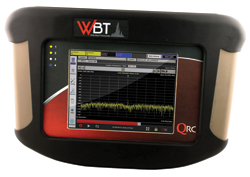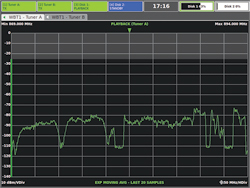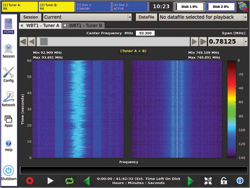
The WBT-200 Wideband Transcorder® by QRC Technologies records and plays back 80 MHz of RF bandwidth, in two separately tunable 40 MHz sections, anywhere between 50 MHz and 6 GHz.
Contained in a single box and weighing less than 10 lbs, the WBT-200 is capable of playing back the recorded signals anywhere within the tuning range without the need for any additional equipment (see Figure 1). It eliminates the need for a separate spectrum analyzer to digitize the signal, a signal generator to play back the RF and a PC to interface and control the unit. The WBT-200’s simple user interface has a single button for RF record or playback.
Many other RF recording and playback systems require additional equipment with numerous interconnects, which increases the total cost of ownership and complicates the test set-up and run procedures for the user. According to QRC Technologies, the WBT-200 has better performance and costs less than other similar products, most of which only collect data and can’t reconstruct and play back the RF.
WBT Applications
The WBT-200 can be used for the following applications:
Reference Signal Recording and Playback: Areference signal (e.g.,test cases, standard compliance vectors) can be recorded, easily recalled and repeatedly played back. The WBT can replace expensive single-purpose communication test sets, which is especially advantageous in manufacturing operations that require numerous workstations to certify products.

Figure 1 WBT-200 display showing RF playback.
Signal Analysis: Analysis can occur while the signal is being recorded, either by playing the recording back or directly analyzing the data.
Market Penetration: Utilization of licensed spectrum can be measured easily and quickly.
Competitive Analysis: A rough comparison of mobile operators can be obtained by measuring the amount of licensed spectrum each utilizes.
Interference Analysis: Looking directly at the spectrum can often determine the presence of an un-licensed signal. Playing back the recording can prove this to the interfering entity.
Training: The RF environment of interest can be recorded and played back to personnel being trained.
Receiver Test and Design: Particular signal configurations and tests can be recorded and played back for a deterministic design and test of RF receivers.
Security: The presence of unwanted transmissions can be detected anywhere in the frequency range.
Arbitrary Waveform Transmitter: Programmatically generated waveforms (e.g., in Matlab) can be easily transmitted.
In the near future, the WBT-200 will also simultaneously record and retransmit 40 MHz of received spectrum in realtime at a different center frequency, enabling it to be used as a repeater or downconverter.
Data Storage and Transfer
The WBT platform records to and plays back from standard 2.5" commercial solid state drives (SSD) using the VITA 49 Radio Transport (VRT) industry standard open format. SSDs have the necessary read and write speeds and ensure a robust,portable product that will withstand shock and vibration.
The WBT-200 includes two drive bays. While data is recorded and played back using one SSD, the other SSD can easily be replaced without affecting the operation of the system. This unlimited disk swapping enables continuous recording and playback, limited only by the number of SSDs available.
Data on the drives can be visualized and analyzed using the WBT’s Signal Analysis Toolkit or other analysis packages that utilize the QVRT file format.
If the signal has less than 80 MHz of instantaneous RF bandwidth, the recording bandwidth can be reduced to conserve disk space.
A gigabit Ethernet port is provided to transfer data from the SSDs over a network, remotely control a WBT and allow one WBT to control other WBTs. Afuture capability will allow data to be streamed directly to another device, at greatly reduced bandwidth. The interface supports both DHCP and static network configuration.
An eSATAp (powered eSATA) port enables additional high-speed disks to be directly connected to the WBT. In the future, data may be recorded directly onto the eSATA disks; however, maximum bandwidth may be reduced, depending on disk performance.
Timing and Synchronization
The WBT-200 contains an embedded GPS disciplined oscillator (GPSDO) that provides a precise internal 10 MHz timing reference, which is made available externally. The oscillator also generates a 1 pulse per second (PPS) signal with ±50 nanosecond accuracy, also available externally. These frequency and timing reference ports can be used to synchronize the WBT with other components, including additional WBTs for simultaneous recording and playback.
The 50-channel GPS receiver has an acquisition sensitivity of -144 dBm and tracking sensitivity of -160 dBm. The RF recordings are tagged with GPS geo-location.

Figure 2 RF spectrogram obtained with the spectrum waterfall app.
WBT Apps
To expand the utility of the WBT-200, QRC has created a series of applications that supplement the role of many test systems. A patented, open architecture application programmer’s interface (API) and VRT-based IQ file format (QVRT) make it possible. The WBT’s core firmware provides the basic hardware level control of the system and application management. Everything else is available through the WBT API and open for anyone to use.
The following free appswill soon be available to download and install from the online WBT App Store:
Spectrum Waterfall: RF spectrogram (see Figure 2).
AGC: Configurable automatic gain control of both WBT receivers.
SCPI Control: WBT control via Standard Commands for Programmable Instruments.
Timed Record/Playback:Record and/or playback files at specified times.
Tune and Dwell: Record specific sections of spectrum for a specific time and loop, if necessary.
Level Trigger: Record when power exceeds a threshold (peak or average), for a user-defined time, and stop recording when the signal falls back below a user-set power threshold.
RF DVR: In a temporary buffer, perpetually store the last received RF data for a user-defined duration. When a user-defined event has occurred, users can write the buffered RF information to the disk and continue to record the RF following the event.
Sweep To File: Sweep from a start to a stop frequency and save the spectrum results as a CSV file for analysis.
Users can also develop custom applications — even resell them through the WBT App Store — using common tools and languages such as C++, Python and familiar programming environments like Qt. QRC offers a full, prepackaged development environment and all necessary documentation.
QRC Technologies
Fredericksburg, Va.
(540) 446-2270
http://wbt.qrctech.com
